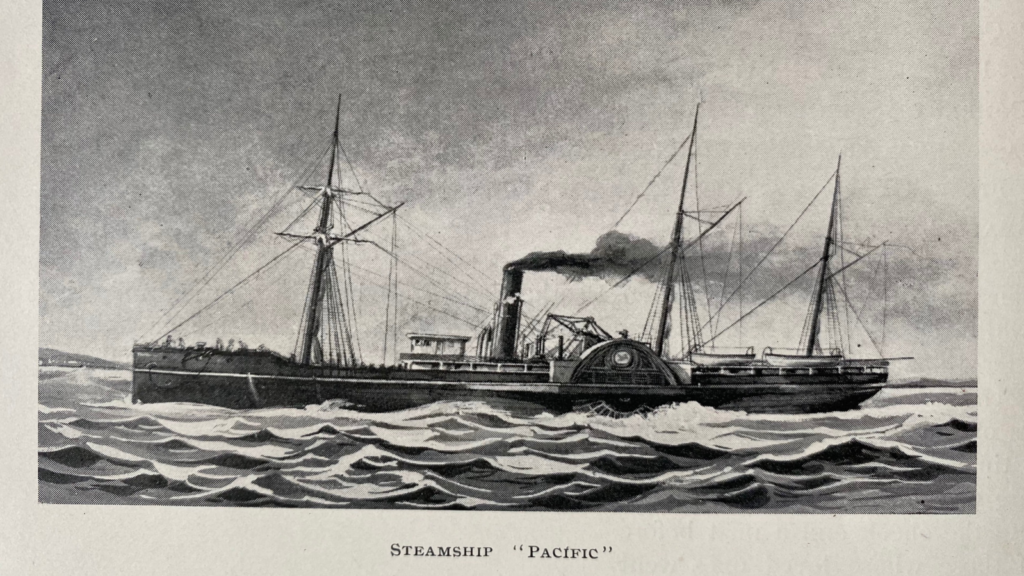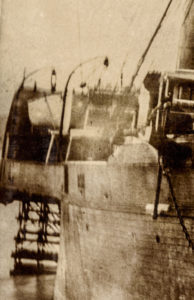Sunken ship lost 150 years ago, found off WA coast

The wreck of a long-lost “sidewheeler steamship” that sank off the coast of Washington nearly 150 years ago has been found by a pair of local maritime historians.
The ship we’re talking about is called the “SS PACIFIC” – a 225-foot long sidewheel steamer. It carried passengers and cargo way back in the time of the Washington Territory
The ship was on its way from Puget Sound and Victoria to San Francisco when it collided with a big sailing ship in the dark off of Cape Flattery on November 4, 1875 – that’s a long time ago!
The sinking of the SS Pacific was a major event
When the PACIFIC went down, it was a terrible tragedy.
The loss of hundreds of lives makes it one of the most – if not the most – deadly maritime disasters in Northwest history.
The guy who led the search for the SS PACIFIC is Jeff Hummel. He’s in his late 50s and he’s been doing underwater recovery of historic boats and planes with his friend Matt McCauley since they were in high school on Mercer Island 40 years ago.
It will be a ‘treasure trove of artifacts’
“The wreck is in remarkable condition. And we believe that it is going to be just an absolute treasure trove of artifacts from this era. You know, an absolute time capsule. We believe that we will find items made of leather, which we believe will find items made of cloth will find bottles of wine. I mean, the state of preservation is really incredible.”
Hummel has been searching for the SS PACIFIC for about 30 years – and he’s certainly not the first to look for it. The fact the wreck happened in 1875 means that reliable data to locate the vessel was hard to come by, and that meant an enormous search area of hundreds and hundreds of square miles.
But, Hummel found an unexpected way to locate the wreck and to confirm that it was the SS PACIFIC through a process that should be called “forensic geology.”
New methods were used to find the ship
“One of the ways that we narrowed down the search was to work with commercial fishermen who occasionally bring things up in their nets. And eventually, we found some fishermen that usually get coal and we actually got a sample, the coal, we had it chemically analyzed and were able to determine that the coal came from a coal mine down in Coos Bay, Oregon that was owned by the owners of the ship and would have been part of the fuel that the ship had from San Francisco.”
More Feliks: MOHAI celebrates 10 years with a look at Seattle’s complicated recent history
Now, they just secured legal salvage rights to the wreck here in federal court. They’re being a little cagey about the specific whereabouts of the wreck, but they do say it’s at a depth of somewhere between 1,000 and 2,000 feet below the surface. They want to protect the wreck and those artifacts, and what could be as much as 200 pounds of gold on board.

Close up of the Pacific’s starboard paddle wheel, 1875. Photo courtesy MOHAI, Seattle Historical Society Collection, SHS11765.
Hummel and the crew he works with have sent down remote-operated vehicles and taken some images of the wreck and the debris field – which they say clearly shows the two sidewheels on the bottom – as if they broke off as the ship sank.
McCauley is leading the historic research efforts and what he hopes will be the preservation and display of the artifacts in a museum.
Many people died in the sinking
McCauley says that in 1875, many miners were leaving Victoria and headed back to San Francisco after being in the Cassiar district of far northern British Columbia, where a gold rush was underway. This means that the SS PACIFIC was packed with hundreds of passengers.
“They were jamming people into the end of the vessel. The carpenters were nailing up bunks in the Salon Deck to accommodate all these people. So that’s not like tickets and they knew exactly they were just cramming them on.”
So no one really knows exactly how many passengers were aboard. It could have been as many as 400 (SAD “and 41 Chinamen”).
Now, about the actual disaster.
Details of the incident
It was around 10 p.m. on the evening of November 4, 1875, as the SS PACIFIC was making its way south near Cape Flattery when it collided with a big sailing ship called ORPHEUS, which was empty and headed north and then east to pick up coal in Nanaimo.
The ORPHEUS was just a few years old and made of 12-inch thick oak, and the SS PACIFIC was 25 years old and was clad in 2-inch thick planks. It was dark, and the ORPHEUS was under sail and was also damaged in the collision. The crew of the ORPHEUS assumed the PACIFIC was okay and had just kept going.
It wasn’t okay and didn’t take very long for the PACIFIC to sink.
Only a handful of details of what happened came to light afterward because there were only two survivors – one who floated around on debris for 40 hours, and another for 80 hours.
Among those lost was the captain, who was the brother-in-law of former Confederate President Jefferson Davis. Another was the husband of Frances Fuller Victor, one of the most important West Coast historians of the 19th century. There are all kinds of stories like that about the SS PACIFIC, so there’s all kinds of research to do.
Site analysis comes in 2023
As far as the wreck, Hummel says the next thing is to do more site analysis next year.
“We’re planning on doing artifact recovery from the debris field next fall, so sometime like September, October of next year, we’ll do that. And the debris field is a few thousand square meters. And we’re going to develop some equipment to recover and preserve the artifacts from there.”
So this is in the early stages of the recovery portion of the project. Jeff and Matt are used to things taking a long time. I mentioned they’ve been doing this sort of thing since high school. One of the first things they ever recovered was a Navy plane off of Sand Point – a Curtis Helldiver – which is under restoration in Colorado and likely to become one of only two remaining examples of that plane that are flyable.
“So Matt and I are responsible for 50% of the flying relics of that particular airplane and it would have been scrapped and melted down into pop cans. If we hadn’t done what we did and we put, we pulled it out at age 19. And when we see it fly, we’ll have literally have our grandchildren with us. Thanks for making me feel young.”
You can hear Feliks every Wednesday and Friday morning on Seattle’s Morning News, read more from him here, and subscribe to The Resident Historian Podcast here. If you have a story idea or a question about Northwest history, please email Feliks here.
[ad_2]
Share this news on your Fb,Twitter and Whatsapp
Times News Network:Latest News Headlines
Times News Network||Health||New York||USA News||Technology||World News